SOMERSET
BATH
Hot springs and bathing facilities.
The mythical king
Bladud
is supposed to have been the first to discover the healing springs of
Bath. It
was the Romans, however who have left us the most tangible evidence of
early
occupation. The Roman Baths have been fully excavated at various
periods during the last century and are open to the public, together
with a related museum and recent excavations on the site of the great
temple of Sul Minerva.
| Visitors
can also see the mediaeval King's Bath, the floor of which was removed
in 1980 to allow access to the Roman reservoir beneath, and the Grand
Pump Room where it is still possible to savour a glass of mineral
water, described by Charles Dickens as possessing the ''taste of warm
flat irons'', though most people these days prefer to order tea and
cakes whilst listening to the strains of Couperin played to them by the
Pump Room Trio. About 100 metres to the west, at the far end of the
colonnaded Bath Street lies the Cross Bath, originally a mediaeval (or
possibly even Roman) bath but rebuilt in the late 18th
century to a design by Thomas Baldwin. The bath achieved fame in 1687
when Queen Mary, wife of James II, successfully conceived and delivered
a son after ''taking the waters'' there.
Opposite
the Cross Bath lies the Hot Bath, largely restored to the original
design of John Wood the Younger who built it in 1776 to replace the
mediaeval Hot Bath which lay immediately to the west. A new Spa
building has finally opened after a series of frustrating set-backs. The Hot Bath, which now
connects with the new spa building, and the Cross Bath have both been
redeveloped to provide public mineral water bathing and traditional
spa-style therapy. |
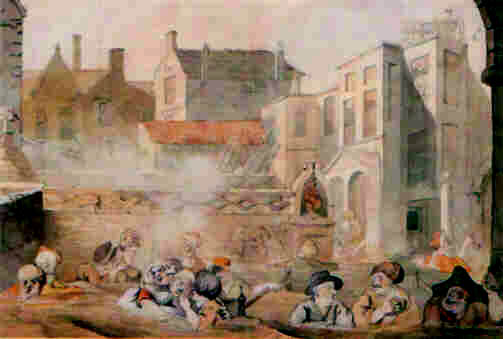
|
| A number of
charitable institutions for the reception of poor visitors and cripples
were established in the city from an early date. Situated close to the baths, the
mediaeval hospital of St John the
Baptist, founded in the 12thC, provides sheltered accommodation for
elderly persons. The current buildings date largely from the 18th and 19th
centuries. |
Ear And Eye Hospital, Walcot Terrace. This tiny
specialist hospital, founded in 1823 is now a funeral parlour. The
front pediment is surmounted by a bust of Hypocrites.
Magdalene Hospital, Holloway.
Once the site of a mediaeval leper hospital, the present building was
used as an ''asylum for idiots'' until the early years of this century.
Hale's Chemist, Argyle Street.
Established in 1826 as a Chemist and Druggist, the business is still a
going concern. The Victorian shop fittings remain largely unchanged and
there is an extensive collection of ''Shop Rounds'' still in situ.
Notice also the fine Coat of Arms on the exterior of the building.
|
Royal National Hospital for Rheumatic Diseases Upper Borough Walls.

|
Founded in 1738, this famous institution was the first national
'specialist' hospitals to be built in this country and opened in 1742
for the reception of impoverished patients whose diseases were amenable
to treatment by the Bath Waters. It remains a specialist hospital but
no longer offers mineral water therapy. The original building was
designed by John Wood and was enlarged, firstly in 1793 by the addition
of an attic storey and later in 1860 by a second building erected on
the west side of the earlier edifice. Little remains of the original
interior, though the basement of the Wood building has suffered the
least alteration.
There is a fine
pediment, in Bath stone, on the 1860 building depicting the parable of
the good Samaritan. The hospital possesses a number of interesting oil
paintings, in particular a picture of Dr Oliver and Mr Peirce
examining three patients in 1741.
|
|
The records of the hospital are incomplete, though there is a complete
set of Minute Books dating from the foundation. A few early admission
registers have been preserved, and there is a book containing c1500
transcriptions of 18th century referral letters often
written by the patients' own doctors and containing much information of
clinical and historical interest. The archival material relating to the
hospital is now kept in the Bath City Archive in the Guildhall.
|
Royal United Hospital. The original
building in Beau Street was, until recently, occupied by city's Technical College. The
present hospital dates from the 1930s and is sited at Combe Park. The earliest
hospital at Combe Park was built to treat injured soldiers returning from the
battlefields of World War I. None of the War Hospital buildings survive. Two
other earlier hospitals on this site remain - the Bath and Wessex Orthopaedic
Hospital (1922) and the Forbes Fraser Hospital (1924) - a small general hospital
for the treatment of those of moderate means who did not wish or could not be
treated at home. It takes its name from a local surgeon.
|
The Eastern Dispensary was established in 1853 and was
one of three such dispensaries in the city where medical and surgical
treatment was available to those of limited means provided they had
obtained a ''Ticket of Recommendation'' from a subscriber to the
charity. The Eastern Dispensary was closed when the NHS was conceived
and the building is currently occupied by a design agency.
|

|
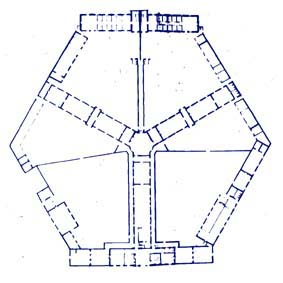
|
St Martin's Hospital, Frome Road. Built in 1834 as a
work
house using one of Sampson Kempthornes hexagonal plans, it has been
largely redeveloped for residential use. The old psychiatric block is
now used as offices for the local Primary Care Trust. Of interest is a
chapel, purported to have been built single handed by one John Plass,
an alcoholic patient during the early work-house era.
|
Bath had a number of important apothecaries gardens in the 17th and 18th centuries but all trace of these have vanished. However there are several modern medicinal herb gardens here, one at Bath University (in the department of pharmacology) , another at Herschell House, 19 New King Street, and a third at the
American Museum,
Claverton,
a small village about four miles from the city centre. The latter
specialises in herbs from the New World . There is a small shop at the
museum selling traditional American herbal medicines.
Amongst the numerous memorials in Bath Abbey are those to several medical worthies including William Cheselden who died in Bath, supposedly after eating a Bath Bun. His apprentice, Samuel Sharpe is also buried here.
To access a list of medical personnel active in Bath before 1837, click here
CHARD
The town's museum includes a collection of artificial limbs by
Mr James Gillingham, a shoemaker who was a resident of Chard at the end
of the last century.By 1903, Gillingham claimed to have treated over
7000 patients. The business was finally closed in the 1960's.
EDINGTON
Holy well.
Described by Collinson in his History of Somerset as a perpetual spring
containing sulphur and steel. "Against the change of weather, it smells
like the foul barrel of a gun. It is very cold, leaves a white crust on
the bodies it passes over and has been found efficacious in scorbutic
cases." The well still reeks of sulphur though the passing traveller
might mistakenly imagine that the cellophane factory at Bridgwater, not
so many miles up wind of the village, had resumed production. The well
was restored in 1937 in memory of Margaret Charlotte Fownes Lutterell but it is looking rather neglected.
FLAT HOLM (Bristol Channel)
Isolation Hospital, see section on
Wales
GLASTONBURY
Instantly identifiable at a distance from it famous Tor, this small market town was once a popular spa which tried to compete with Bath for patients during the 18th
century. The spring's discovery is attributed to a short-winded local
yeoman, one Matthew Chancelor, who was guided to its position in
October 1750 after a vivid dream. A pump room was constructed over the
source in 1754 and survives as private house in Magdalen Street, next
to the Copper Beech Hotel. The Somerset Rural Life Museum has
a curious example of local folk medicine in the form of a willow tree
with a split trunk through which infants and young children with herniae were
passed in the belief that their ruptures would disappear. ( c.f.
Madron, Cornwall). (The museum also owns a collection of early surgical
instruments but these are not usually on public display and application
to the curator is needed to view.)
KEWSTOKE
|
Woodspring Priory.
Purchased by the Landmark Trust
in
1969, the priory was originally founded in the early thirteenth century
as an Augustinian house. Amongst the surviving buildings which have
been repaired by the Trust is the priory's infirmary.
It measures 44 feet by 20 feet and was originally paved with limestone
slabs of which a few remain. The original entrance was from the
cloisters at the west end but these have long since disappeared. On the
outside south wall, there is a curious semicircular indentation which
marks the position of a former spiral staircase. This was sited in the
infirmary's chapel which was annexed to the south corner of the current
building before its demolition. The staircase probably gave access to
the infirmarer's quarters. There is a notable absence of a fireplace in
the infirmary hall and it has been suggested that heating was provided
by a central hearth, the smoke from which was carried away by a
formerel (a lath and plaster or wicker chimney) which led up to a hole
in the roof, a fine example of fifteenth century arch-brace collar beam
timberwork which has three tiers of windbraces |
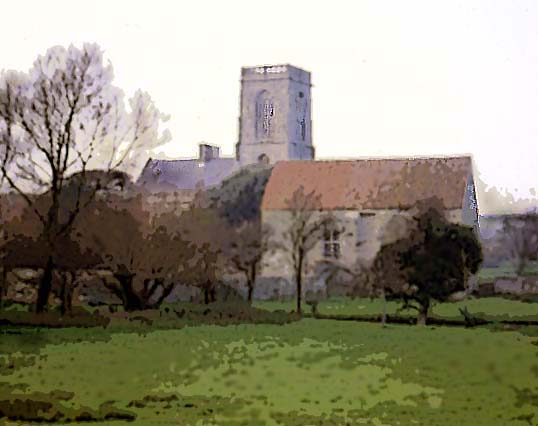 |
| After the priory
was dissolved by Henry VIII in 1536, the church suffered an unusual
transformation into a dwelling house, complete with added chimney
stacks built up through the nave. The tower, also dating from the
fifteenth century, was left intact and has been skilfully repaired in
recent years. The infirmary may have been used as a hospital for
wounded soldiers during the 17th and early eighteenth
century as contributions towards such an institution are mentioned in
the local parish records. The last recorded payment was made in 1734.
The infirmary and the church are open to the public during daylight
hours. |
TAUNTON .
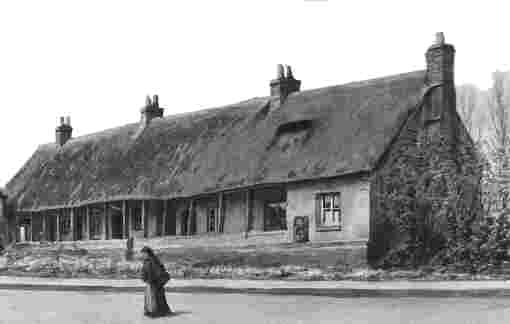 St Margaret's Leper
Hospital (left)
in East Reach was founded as a leper hospital in the 12th
century. It was rebuilt in the early 16th century as almshouses, under the
patronage of the Abbot Bere of Glastonbury Abbey.
In 1938 the building was converted to become the headquarters of the Somerset
Guild of Craftsmen and Rural Community Council. In the late 1980s the Guild
moved to other accommodation and the building became derelict, after being
damaged by fire. The Somerset Building Preservation Trust and the Falcon Rural
Housing Association have recently repaired and converted the building into four
small houses.
St Margaret's Leper
Hospital (left)
in East Reach was founded as a leper hospital in the 12th
century. It was rebuilt in the early 16th century as almshouses, under the
patronage of the Abbot Bere of Glastonbury Abbey.
In 1938 the building was converted to become the headquarters of the Somerset
Guild of Craftsmen and Rural Community Council. In the late 1980s the Guild
moved to other accommodation and the building became derelict, after being
damaged by fire. The Somerset Building Preservation Trust and the Falcon Rural
Housing Association have recently repaired and converted the building into four
small houses.
Taunton General
Hospital, South Road. "Standing
on a delightful eminence, at a proper distance from the town in the
midst of a large plot of garden ground...is...a large and very
commodious hospital." But the building with its foundation stone, laid
by Prime Minister Lord North on 29th September 1772 and inscribed "for
the relief of the sick poor" was destined to become a convent. In 1780,
subscriptions to the proposed hospital had fallen so short of their
target that the builders, tired of waiting for their dues, abandoned
the works and left the building to the mercy of vandals and the
elements. As a local historian put it, the incident "blasted the hopes
of the afflicted." The first general hospital at Taunton was ultimately
built in 1812 in East Reach, by which time the original building had
been sold for conversion into a private dwelling for one of the town's
medical practitioners. " The hospital that never was" is now owned by
King's College, one of the town's several Public Schools. It is not
accessible to the public and can only be viewed by special permission
from the school.
SHAPWICK
Holy well. Small
pump room with an enclosed bath was built in 1830 and Dr Beddoes of
Bristol
analyzed the water and proclaimed it on a par with Harrogate water. The
building has long since decayed and is no more than a heap of stones,
though still optimistically referred to as the Bath House.
SWAINSWICK
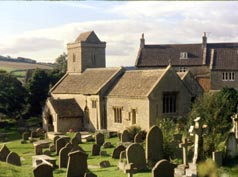 |
Dr John Haygarth, who moved to Bath from Chester,
is buried in this country parish and there is a memorial plaque on the
wall inside the church. In 1800, Haygarth performed one of the earliest
comparative clinical trials to examine the placebo effect of Perkin's
Tractors, a popular quack cure of the time. |
WELLS
Cathedral
Library. A
former Bishop of Bath and Wells, Nicholas Bubwith, bequeathed money for
building a library over the eastern walk of the cloister in 1424 where
it remains today and houses a
remarkably fine collection of books and incunabula , a considerable
number of which are of medical and scientific interest and include a
five volume set of Aristotle's Works printed in Venice in 1495-8 which
formerly belonged to the famous humanist Erasmus. The library also
possesses works by Avicenna (d.1037) , Ralph Bathurst (1620-1704),
Robert Boyle (1627-1691) and Sir Thomas Browne (1605-1682) as well as
many others. The surviving volumes of the old Bath Abbey library have
been incorporated into this collection and contain a manuscript
believed to have been the work of the prominent 17th century Bath
physician Robert Peirce.
Dr Claver Morris' House. Now
part of Wells Cathedral School, this fine house in the Livery was once
the home of Claver Morris (1659 - 1726) whose diary provides a
fascinating glimpse of the life of a country physician working nearly
three centuries ago. His elaborate
memorial, commemorating fulsomely and in Latin his skills in music,
chemistry and physic, and topped by a bust, can be seen in the
cathedral cloisters. Another house belonging to an 18th medical family
called Pulsford, can be found in New Street (now a bank). The
Pulsfords' Account Book, in the Somerset Record Office at
Taunton, provides an illuminating record of 18th century general
practice. In 1739, quintuplets were born to a woman living in Wells.
The Old Deanery Garden,
9 Cathedral Green commemorates the physician, naturalist and religious
contraversialist, Dr William Turner (1508-1568) who was Dean of Wells
in the 1550s and 1560s. The plants growing in the garden represent a
selection of those mentioned in Turner's Herbal. The garden is open to
the public on Wednesday afternoons during June, July and August.
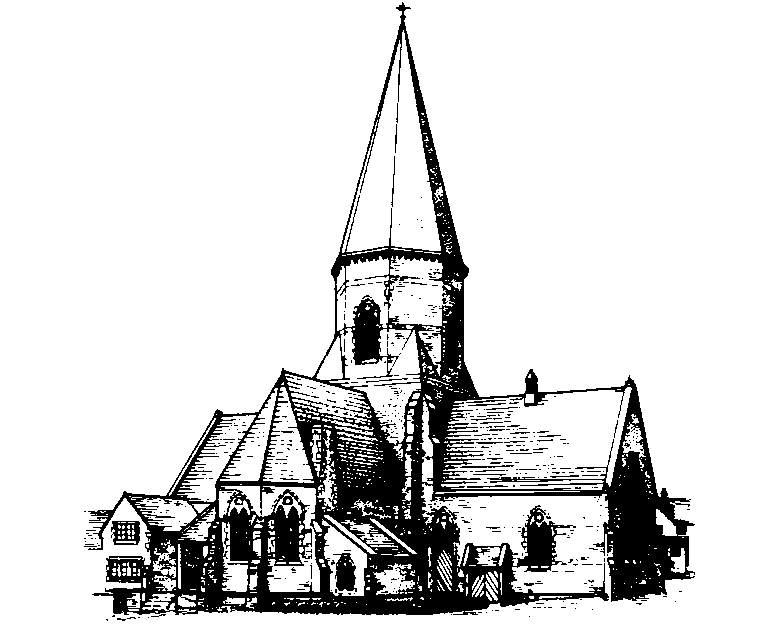
|
The Mendip Hospital was built in the mid 19th century to the design by Sir Gilbert Scott and served as the County
Asylum. It is an imposing red brick building dominated by a central
spired tower and a chapel in the style of the Gothic Revival. The
buildings, including the chapel (left), have been converted
into dwellings which are now known as St Cuthbert's Village.
|
| WEDMORE |
|
|
Porch House.
The home of Dr John Westover (1643-1706), who
was a pioneer of the humane care of the mentally ill. He succeeded his
father, another John, who practised here until 1678. His
father's tomb in the church is inscribed "Repent, for doctor's dye''
though
much of the gravestone is obscured by the font which was subsequently
placed
over it.
The younger John Westover built the Madhouse alongside
Porch House in 1680 and this still survives. Westover's Journal, an
important manuscript which covers the years 1685-1700, can be viewed in
the Somerset Record Office at
Taunton and downloaded from the web via the Wedmore
Genealogy Pages.
|

|
WIVELISCOMBE
Infirmary.
In 1804, Dr Henry Sully and a surgeon
colleague Mr Bishop Cranmer opened an infirmary and dispensary for the
benefit of "servants, apprentices, labourers and mechanics.'' Dr Sully
was sufficiently well connected to become surgeon to the Duke of
Cumberland who later became King of Hanover. The Wiveliscombe Infirmary
and Dispensary eventually became the premises for the local GPs until
they moved into purpose built premises.
YEOVIL
Penn Villa.
William Hunt first used ether as a dental anaesthetic
in this house at Christmas 1847, a year after its first European use by
London surgeon James Robinson. Hunt's son, also William, published the
earliest English paper on the use of hypodermic injection of cocaine as
a local anaesthetic in 1886. Their house is still a dental surgery more
than a century and a half later.
Gazetteer





